Nothing adds an exotic allure to a summer garden, much like the fantastically flowering hibiscus plant. There are two commonly grown types of hibiscus, one ideal for outdoor growth and the other ideal for indoor growth.
This means you can have fantastic hibiscus flowers growing throughout your home and garden. Here is everything you need to know to cultivate, care for and grow hibiscus at home.
More...
Genus: | Hibiscus |
|---|---|
Family: | Malvaceae |
Common Name: | Hibiscus, Rose Mallow, Rose of Sharon |
Location: | indoor or outdoor |
Type: | perennial herbaceous plant (mostly hardy) |
Growth: | 1mx1m avg. |
Sun requirements: | Full sun – partial shade |
Foliage Colour: | Pale green |
Flower Colour: | Pinks, Whites, Reds, Oranges |
Flowering: | Summer |
Fruit: | None |
Maintenance level: | Low |
Poisonous for pets: | Some species are toxic to dogs. Most species are toxic to cats. |
What is Hibiscus?

Hibiscus is a widespread and diverse group of flowering plants, grown for indoor and outdoor colour. The most common hibiscus you can grow in Australia is Rose of Sharon, a pink flowering hibiscus with a red centre and pale, matt green leaves with lobed edges.
All hibiscus grow best in full sun but do like some shade from the midday sun to prevent the soil from drying out completely at the roots. However, if you want a variety more native to Australia then check out our growing guide for Hibiscus heterophyllus also known as Australian Native Hibiscus.
Hibiscus’ Natural habitat
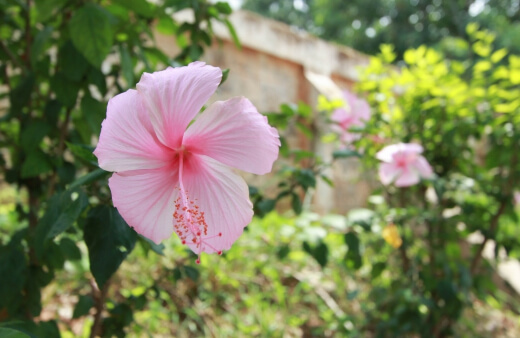
Hibiscus has been cultivated as ornamental plants for as long as botanical records go back, but the eight species that share their genes with modern cultivars are native to China, India, Madagascar, Mauritius, Fiji and Hawaii.
Their sporadic spread around the globe indicates their ability to withstand a variety of conditions, but all share one thing in common – they are warm, humid climates, mostly falling in the tropics or subtropics.
Is Hibiscus Edible?
Hibiscus is an edible flower that is best used in teas, or to flavour syrups as the flavour comes out best through steeping, and matures well in the drying process, giving a much richer, earthier flavour to accompany its sweet fragrant notes.
There are some exceptions to the rule though, as Rose of Sharon causes stomach upsets in pets and humans when consumed raw.
The most commonly grown edible Hibiscus is H. sabdariffa, with a distinct bitter flavour usually described as cranberry, but which I find to be slightly citrusy with a touch of blackberry and rosehip.
Types of Hibiscus
Before planting, it’s a good idea to know the difference between the types of hibiscus. Although both types are native to Southern China and accustomed to warmer, humid weather, only one cultivar is well suited to be grown indoors.
- Hardy Hibiscus. This deciduous cultivar, also known as Hibiscus syriacus, is a perennial species ideal for outdoor growth. This variety grows much like a shrub, producing single flowers ranging in colour from red to white to pink to lavender.
- Tender/Tropical Hibiscus. The evergreen Hibiscus rosa-sinensis is a tropical cultivar better suited to the indoors. This ideal houseplant comes in both single or double bloom varieties. Its blooms usually come in magnificent oranges, pinks and yellows.
Best Hibiscus Varieties to Grow in Australia
There are over 400 species of Hibiscus but there are five in particular which make up the vast majority of garden cultivars which are easy to grow, simple to care for, and some have intensely impactful flavour too.
The list below is our favourite species, and within each species, there are some unique variations in colour and leaf form through hybridisation.
1. Rose of Sharon | 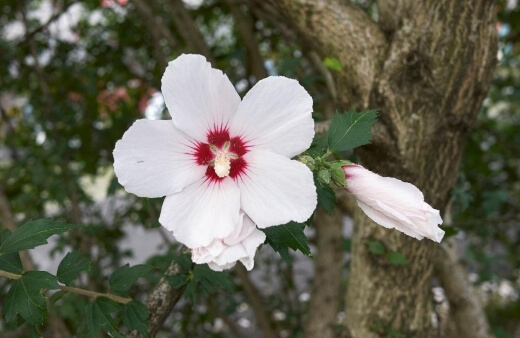 |
2. Rosemallow | 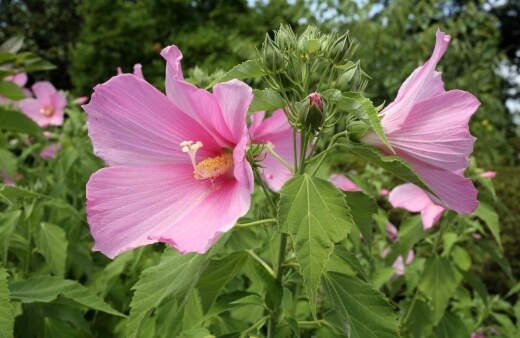 |
3. Scarlet Rosemallow |  |
4. Hawaiian Hibiscus |  |
5. Comfortroot | 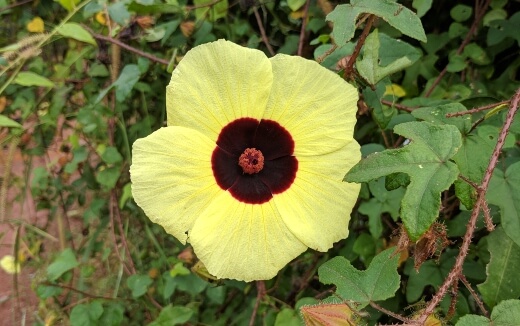 Source: en.wikipedia.org |
1. Rose of Sharon (Hibiscus syriacus)

Rose of Sharon is the common hibiscus, grown throughout the world as a low maintenance plant with shown blooms. The pure species plants have pinky-white flowers with red centres, but there are many variations in colour, ranging from deep burgundy flowers to brilliant white.
2. Rosemallow (Hibiscus moscheutos)

Rosemallow are the showiest hibiscus plants, and will grow happily indoors or out, but prefer to be outdoors in a sheltered spot away from the wind, but with good morning and evening light.
While rosemallows like full sun, it's important to keep it very well watered as it prefers to grow naturally alongside streams and lakes in damp soil.
Plant rosemallows beside a pond in the garden to attract pollinators and flying insects.
3. Scarlet Rosemallow (Hibiscus coccineus)

Scarlet Rosemallow are native to tropical America and are found wild in southern states of the USA. They are happy in any damp soil, with plenty of light and are often called the swamp mallow for that reason.
The only extra care worth noting from Scarlet Rosemallow is to mulch generously every winter to keep the soil warm at its roots. In Northern Australia, this is still necessary to prevent roots from drying out over winter.
4. Hawaiian Hibiscus (Hibiscus brackenridgei)

Hawaiian hibiscus grows as small shrubs but can be pruned into a tree form. They lose their leaves in winter but come back each year with a flush of new leaves and showy yellow flowers, which are traditionally used in Hawaiian leis.
5. Comfortroot (Hibiscus aculeatus)

Source: en.wikipedia.org
Comfortroot are incredibly easy to grow and spread through borders once established. Keep comfortroots well-watered but avoid leaving them in standing water where possible.
Their flowers are much more subtle than most other Hibiscus species, but they are becoming more common in garden centres as gardeners seek to create gardens geared more towards wildlife and naturalistic planting.
How to Grow Hibiscus Flowers

How to grow hibiscus will depend on which types you are choosing to grow. So, here’s a look at what you’ll need to know for each type:
Growing Perennial Hibiscus
As the name suggests, this variety of hibiscus is a lot more tolerant when it comes to environment and weather conditions. Nonetheless, you’ll want to choose a slightly sheltered spot that gets plenty of sunlight throughout the day.
Hardy hibiscus prefers well-draining, loam-based soils. If planting directly into the ground, you may want to consider preparing your soil with some compost and organic matter before planting.
Planting of this cultivar should be done during spring.
Growing Tropical Hibiscus
This cultivar is perfectly suited to warm, high-humidity conditions, which make it perfect for spaces like your bathroom. Plus, it grows best in bright, indirect sunlight, meaning it doesn’t necessarily need to live on a windowsill.
A well-draining, peat-based potting mixture should be used for tropical hibiscus. Planting should be done in late spring or early summer.
Certain species of tropical hibiscus can also be grown in a pot outdoors during the summer and brought indoors during the winter.
How to Plant Hibiscus

If you’re planning to growing hibiscus in the ground:
- Prepare the soil with some rich organic matter or compost.
- Dig a hole twice the size of the root ball, which is about equally as deep.
- Settle the base of your hibiscus into the hole.
- Backfill with a rich organic soil mixture.
Water well after planting.
For indoor plants or container growing:
- Choose a pot that is no bigger than twice the size of the rootball.
- Using a well-draining potting mix, place the root ball on a small mound of soil and backfill until the soil sits well around the base.
- Gently press down the soil with your hands to remove any air pockets.
Should you be looking for some other tropical plants to add to the mix, here’s a quick guide to help you find some of the most fantastic Australian native tropical plants.
Hibiscus Care Guide
For the ultimate array of hibiscus flowers during the summer, your hibiscus plant will need some extra attention, especially the indoor variety. In general, both cultivars require regular watering during the growing season. Over autumn and winter, you can almost cut back completely.
As a rule of thumb, conduct a regular test by pressing a finger into the soil. If some soil sticks to your finger, there is sufficient moisture. Avoid allowing the soil to dry out completely.

Caring for Outdoor Hibiscus
If growing hardier types of hibiscus outdoors, it is recommended to regularly mulch around the base. This will help to deter any weeds and retain soil moisture. A slow-release fertiliser can be added annually during the spring to support growth.
This species responds particularly well to pruning, which should be done once all of the hibiscus flowers are spent. Don’t be dismayed should your hibiscus die back during the winter; it will bounce back.
Simply prune back dead stems until about 10 cm above soil level. How to prune hibiscus is fairly straightforward. Here is our review on the best gardening secateurs to help you in your pruning tasks.
Caring for Indoor Hibiscus
Indoor, tropical hibiscus will need far more regularity when it comes to watering. Be sure to keep the soil moist and conditions as humid as possible. Some growers recommend keeping your hibiscus in the bathroom when you shower to help boost humidity.
Feeding for this cultivar can be done fortnightly, with a general-purpose fertiliser. This species responds well to an annual prune, where you can cut back growth to as much as 5-7.5 cm above soil level.
For container growing, it is also recommended to re-plant every year or two.
If you have left your tropical hibiscus outdoors for the summer, be sure to trim back growth and cleanse the leaves of any pests before bringing them indoors over winter.
Keep your hibiscus in a warm location with plenty of indirect sunlight. Allow the soil to dry slightly before watering.
Hibiscus Propagation
Hibiscus cuttings are really easy to take and will flower reliably in their first year after rooting, but it is also possible to grow hibiscus from seed. Below, we’ll look at two methods to grow your own hibiscus.
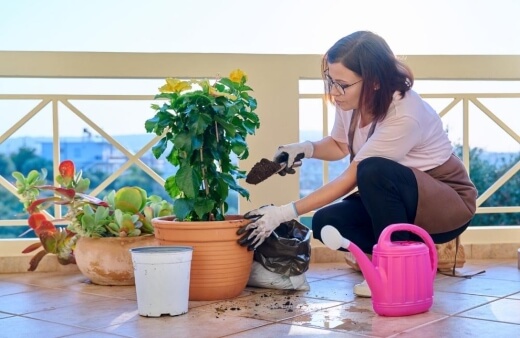
Growing Gibiscus from Seed
Hibiscus seeds have hard outer shells which need soaking overnight or lightly sanding before sowing (not both). After preparing your seeds by softening the shell, place them in a seed tray on the surface of seed compost, or clean, free-draining compost with perlite mixed through.
Sow seeds about 3cm apart to make pricking out easier later. Cover your seeds with 5mm of compost, then water well. Leave the seed tray somewhere bright and warm for 2-4 weeks until germination happens, watering when the compost dried out.
After germination, wait for true leaves to appear. Then, gently prick out seedlings into small individual pots to grow on.
Propagating Hibiscus from Cuttings
Tropical hibiscus and hardy hibiscus take well from cuttings and are a reliable way to create a perfect copy of the parent plant without risking hybridisation with nearby hibiscus plants.
To take hibiscus cuttings, you will need late spring growth called softwood (branches which haven’t developed thick outer skins or bark).
Cut hibiscus just below a leaf node, taking around 10-15cm of new growth from a non-flowering shoot. Remove any foliage other than the top set of leaves, and dip the cut end in rooting hormone.
Place your cutting in loose soil (a 50:50 mix of spent compost and perlite is perfect). Gently insert your cutting into the soil, and soak it.
Place a bag over your cutting to increase humidity, and place somewhere warm but shaded for around two months. Only water the cutting if the soil dries out
See our complete guide on taking cuttings to help boost your plant propagations.
Potential Hibiscus Problems
Most issues only arise when the conditions for growth are unideal. Usually, this will have to do with the level of humidity. Some species experience a bud drop-drop should the humidity levels be too low. This happens, particularly with the tropical varieties.
The only other issue you may have in low-humidity conditions is an invasion of red spider mites, which thrive in dry soil conditions. Improving the humidity and soil moisture should help to curb this issue.
Hibiscus Frequently Asked Questions
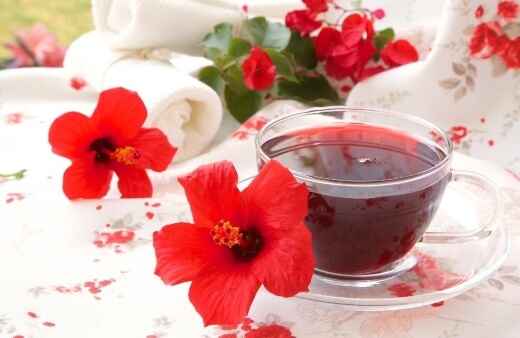
What is hibiscus used for?
Hibiscus tea has plenty of benefits. It is thought to boost the immune system and improve overall health thanks to high concentrations of antioxidants, which reduce the risk of heart disease and improve skin health and anthocyanins which are antioxidants but also have anti-inflammatory properties.
Does hibiscus come back every year?
Hibiscus are perennial plants and will return to the gardens every year. Some indoor tropical varieties are not frost-hardy so will either need to be protected from winter in southern Australia, or brought indoors if there is a prolonged risk of frost.
Does hibiscus like sun or shade?
Hibiscus plants prefer full sun, but do like some protection from midday sunlight in summer, so choose a spot that gets plenty of bright light but some shade in the afternoon to prevent soil from becoming too dry.
What months do hibiscus flower?
Hibiscus flowers from mid to late summer and will continue flowering for around 4 weeks, though this can be extended with plenty of water and regular deadheading to around 6 weeks into late summer.
For more alluring flowers for your garden, check out our guide on growing the Wahlenbergia Gloriosa, commonly known as Royal Bluebell.

Grow Beautiful Hibiscus in Your Garden
Hibiscus really is a statement piece to add to your home or garden, and now is the perfect time to start planning. Be sure to choose the right variety for where you intend to plant.
For the outdoor variety, make sure you give it lots of adequate sunlight. For indoor varieties avoid the direct sun but choose a spot that still receives enough brightness. There you have it, everything you need to know on how to grow hibiscus flowers in your home.
Published on June 25, 2022 by Lorri Hopkins
Last Updated on February 21, 2024




